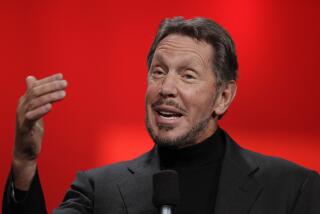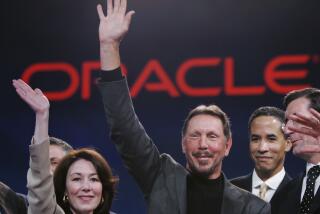Company Town : For Roy Disney, Legacy Is Everything
When Michael D. Eisner installed the Seven Dwarfs atop Team Disney headquarters in Burbank as enduring symbols of the company’s heritage, he might just as well have added the image of Roy E. Disney.
The painfully shy and enigmatic executive with the uncanny resemblance to his Uncle Walt has a habit of popping up at critical junctures in the company’s history to somehow help sway events his way.
Roy Disney’s fingerprints were all over the management coup that ushered in the Eisner-Frank G. Wells regime 10 years ago. Now he’s helped to derail the ambitions of Wells’ would-be successor--studio Chairman Jeffrey Katzenberg.
“Roy’s a very clever, skillful man,” one associate said Thursday. “He’s not openly aggressive, but he always gets what he wants. Maybe the cardigan sweaters lull people.”
Sources close to the company say that from the start, Disney was openly hostile to Katzenberg succeeding Wells as president. As a close friend of Wells, he resented Katzenberg’s intense lobbying for the corporate post. But even before that, the Disney heir and Katzenberg were on troubled ground.
Sources say the two executives rarely if ever spoke in their 10 years together and that Disney, whose job includes overseeing the animation department, zealously guarded from Katzenberg’s eyes his work on the sequel to the animated classic “Fantasia.”
Katzenberg loyalists attribute Disney’s actions to jealousy, saying he was intimidated and overwhelmed by the studio chief’s gale-force energy and intense interest in the animation business. “Roy Disney doesn’t run animation,” one Katzenberg friend said. “He’s on a boat in Ireland half the year.”
But Disney told friends that the dispute boiled down to Katzenberg’s ego. In conversations in recent years, he repeatedly complained that the studio chief was hogging all of the credit for the spectacular success of animated features such as “The Lion King” and “Aladdin.”
It may have been to Roy Disney’s benefit that Katzenberg’s all-star executive and news media schmoozing skills did not extend to corporate politics. Sources say the studio chief never bothered to develop close personal ties to the members of the board, which undercut his chances of overcoming Disney’s opposition.
*
Despite Katzenberg’s phenomenal success in managing the Disney studio operations--annual filmed entertainment operating income alone rose from $2.2 million in 1984 to $622.2 million in 1993--Eisner and the other board members shared Roy Disney’s reservations about putting the studio chief in a corporate role. Sources say Disney’s behind-the-scenes work--augmented by the vociferous anti-Katzenberg rhetoric of director Stanley P. Gold, who heads the Disney heir’s Shamrock Holdings--clearly greased the path for Eisner to push Katzenberg out the door.
Board member Raymond L. Watson said Thursday that Disney “has a legitimacy that comes from both the amount of stock he owns and his heritage,” adding, “When he speaks at the board meetings or speaks to animators, they know this is not just a paid executive but someone whose life has been nurturing the company.”
At 64, Disney holds the title of vice chairman of the board, but his role is much more expansive than that. He demanded and received the job of supervising animation in the 1980s, when Eisner and Katzenberg wanted to scrap the division. He has since become a trusted adviser to Eisner, who sees in him a non-threatening corporate presence who also carries the prized family name.
“Michael has gone out of his way to give Roy his dignity,” said one source. “He’s been loyal to Roy for bringing him to the company, and he’s been a smart politician.”
Sources say the pair’s bond has grown even stronger since the company was shaken by two dramatic recent events: Wells’ death in a helicopter crash in April and Eisner’s emergency quadruple heart bypass surgery last month. Disney rushed in from his seaside castle in Ireland to be at Eisner’s side, and a company statement pointedly named him as Eisner’s stand-in.
*
It was an unaccustomed moment in the sun. Despite inheriting Walt Disney’s physical features, Roy has practically none of his late uncle’s famous charisma, close friends readily concede.
Puffing on an ever-present cigarette, he can usually be found holding up the wall at corporate events. One entertainment analyst says Disney has played no visible role in the company’s investor gatherings in recent years, though Eisner and Wells may have been throwing him a bone at the annual meeting in Florida earlier this year when they allowed him to make the formal announcement that the company was finally releasing the animated “Snow White” on videocassette.
At the same time, sources say Disney has become more vocal at board meetings and that his opinions are taken seriously by colleagues. Aside from his work at the family store, he has profited handsomely from Shamrock Holdings, the investment company led by Gold. The firm made a fortune buying and selling soybean-processing giant Central Soya.
*
While he has cut back on his work schedule the last three years, people close to Disney say his passion for protecting the company’s legacy is what keeps him going long after he could have retired on a nest egg valued at $540 million.
His ties to and love of the company’s animation date back to before Eisner, Katzenberg and most other Disney executives were even born.
Roy’s mother inked and painted animation cels of Mickey Mouse while she was pregnant with him. As a boy in the 1930s, he watched “Snow White and the Seven Dwarfs” 20 times while it was moving through the production process. At age 7, he was too sick in bed one day to attend a “Snow White” screening. So Uncle Walt dropped by to try out a story on him about a puppet named Pinocchio that he was thinking of making into a film.
Roy Disney, whose father co-founded the studio while never drawing anywhere near the attention of Walt, later went to work on the Burbank lot as a film editor, producer and writer. But he was resented be some colleagues because of his family connection and derided by others as the “idiot nephew” for his diffident and uncommunicative style.
Even while serving on the board before the 1984 power shift, he rarely said much in meetings, something friends now attribute to the overall lack of respect he was accorded then.
That changed drastically 10 years ago, when Disney and Gold engineered the ouster of the company’s beleaguered management team in favor of Eisner and Wells, who orchestrated one of the most successful turnarounds in U.S. corporate history.
While Disney spends much of his time at his vacation home in Ireland, sources say he is still involved in the day-to-day operations of the company’s vaunted animation department, which was supervised by him, Katzenberg and animation chief Peter Schneider before the recent upheaval.
*
People close to the studio say it was Roy Disney who pushed the company into paying for the expensive automated equipment that allowed its animators to move into the modern age.
Responsibility for success or failure is always a murky thing in Hollywood. But on the creative side, one executive describes the Disney heir as “a big-picture guy,” whereas Katzenberg focused on the finer points of character and script development.
“No one plays the bully role in animation. It’s too collaborative for that,” said one source. “But Roy puts forward ideas. He’s very creative, he gives great notes and he’s certainly no idiot. It’s not just by luck that all this this has happened to him.”
More to Read
The biggest entertainment stories
Get our big stories about Hollywood, film, television, music, arts, culture and more right in your inbox as soon as they publish.
You may occasionally receive promotional content from the Los Angeles Times.










